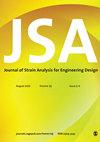Optimal shaft-hub connections
IF 1.4
4区 工程技术
Q3 ENGINEERING, MECHANICAL
Journal of Strain Analysis for Engineering Design
Pub Date : 2022-03-09
DOI:10.1177/03093247221080016
引用次数: 1
Abstract
In all power transmitting machines the shaft-hub connection has a large impact on the overall machine size, if the strength can be increased we can reduce the size. The connection between shaft and hub is a machine element with many possible designs available and described in standards. The connection can be either permanent or changeable, the goal is in all cases to have as high a strength for the connection as possible. Focus is in the present paper on the connections with easy assembly and disassembly, that is, on positive connections (geometrically locked). The designs specified in standards are traditionally made with straight lines and circular arches. Alternatively the involute spline can be used. For this case the cutting tool shape is made with straight lines and circular arches. Present standard designs are not made with minimum stress concentrations as the main objective, other features as for example, easy manufacturing has the primary importance. In the present paper we show how the involute spline design can be significantly improved in relation to strength maximization by reducing the maximum stress. The maximum stress can in many cases be reduced by more than 54 % relative to standard design.最佳轴毂连接
在所有动力传动机械中,轴-毂连接对整机尺寸影响很大,如果能提高强度就能减小尺寸。轴和轮毂之间的连接是一个机械元件,有许多可能的设计,并在标准中描述。连接可以是永久的,也可以是可变的,在所有情况下,目标都是使连接具有尽可能高的强度。本文的重点是易于组装和拆卸的连接,即正连接(几何锁定)。标准中规定的设计传统上是用直线和圆拱制成的。也可以使用渐开线花键。在这种情况下,刀具形状是由直线和圆拱制成的。目前的标准设计不是以最小的应力集中为主要目标,其他特征,例如,易于制造是最重要的。在本文中,我们展示了渐开线花键设计如何通过减少最大应力来显著改善强度最大化。在许多情况下,相对于标准设计,最大应力可以降低54%以上。
本文章由计算机程序翻译,如有差异,请以英文原文为准。
求助全文
约1分钟内获得全文
求助全文
来源期刊

Journal of Strain Analysis for Engineering Design
工程技术-材料科学:表征与测试
CiteScore
3.50
自引率
6.20%
发文量
25
审稿时长
>12 weeks
期刊介绍:
The Journal of Strain Analysis for Engineering Design provides a forum for work relating to the measurement and analysis of strain that is appropriate to engineering design and practice.
"Since launching in 1965, The Journal of Strain Analysis has been a collegiate effort, dedicated to providing exemplary service to our authors. We welcome contributions related to analytical, experimental, and numerical techniques for the analysis and/or measurement of stress and/or strain, or studies of relevant material properties and failure modes. Our international Editorial Board contains experts in all of these fields and is keen to encourage papers on novel techniques and innovative applications." Professor Eann Patterson - University of Liverpool, UK
This journal is a member of the Committee on Publication Ethics (COPE).
 求助内容:
求助内容: 应助结果提醒方式:
应助结果提醒方式:


